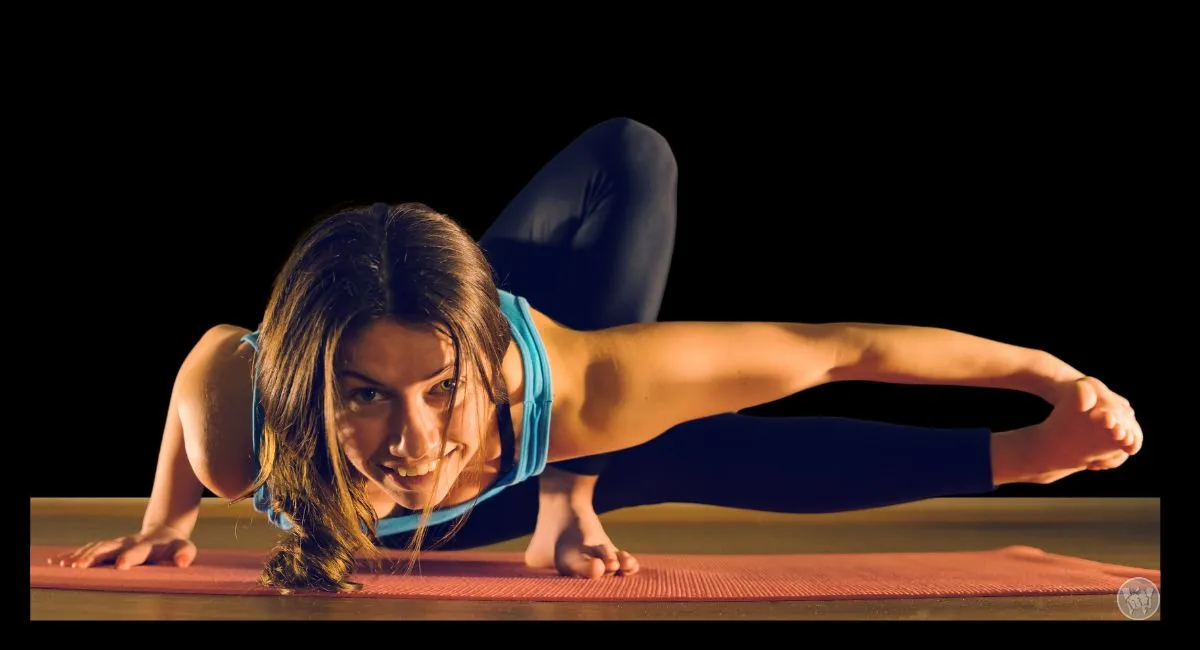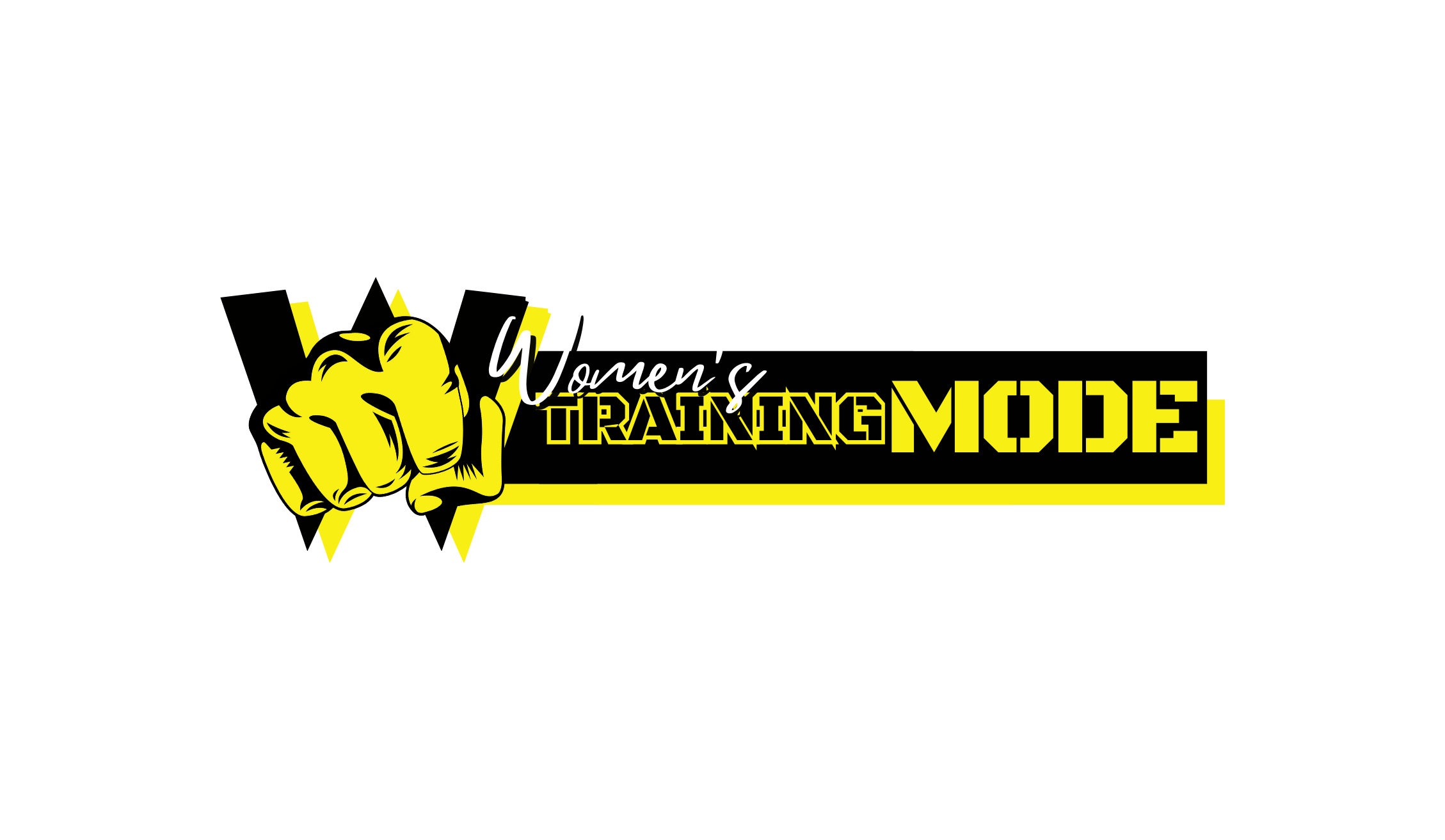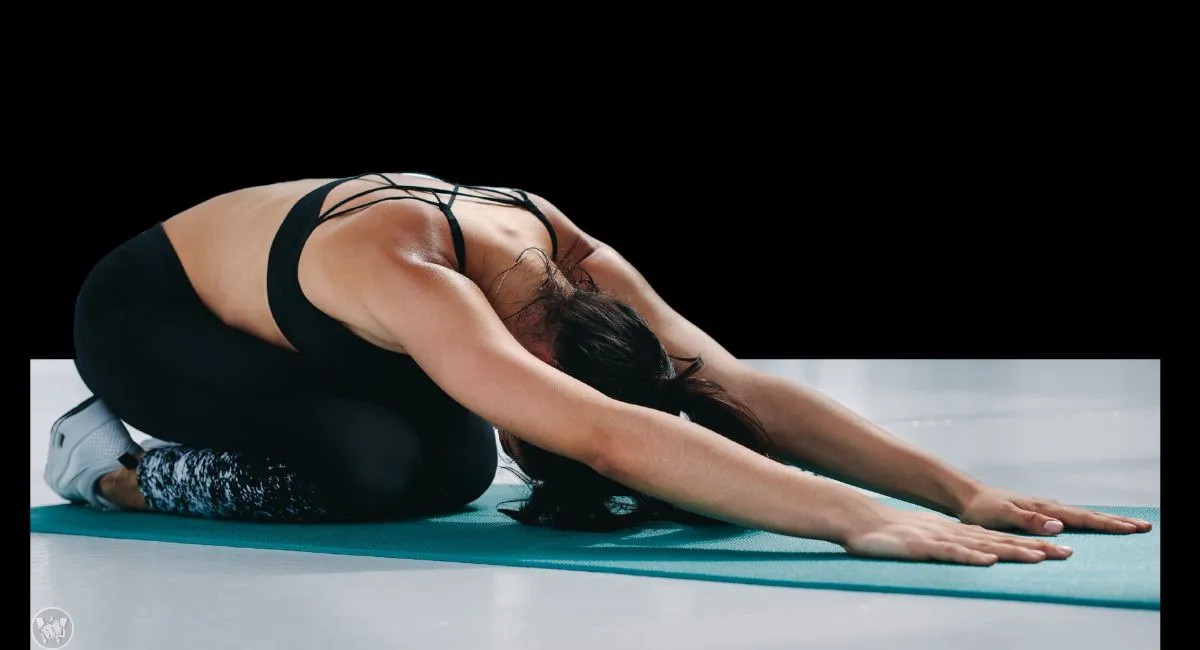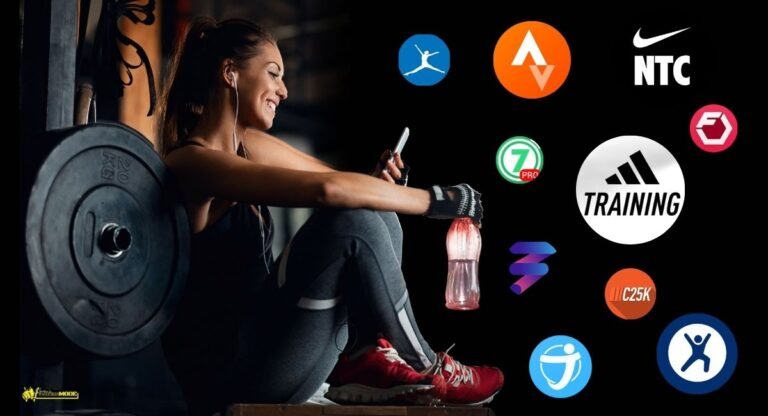Flexibility goes beyond simply touching your toes.
It promotes a greater range of movement, helping with everyday activities and physical exercise.
Let’s find out how it can benefit you!

Starting Your Flexibility Training: The Art of Warming Up
Set yourself up for success!
Entering the world of flexibility is an exciting journey to improve your well-being. However, before venturing out, it’s crucial to understand the fundamental importance of a proper warm-up.
This step not only acts as a safeguard against injury but also functions as the key that opens the door to the muscular preparation needed on the road to flexibility.

The Importance of Warming Up:
An Essential Step
Prevent Injuries and Optimise Your Performance
Warming up is more than a formality before training. It’s a crucial physiological principle that offers several benefits:
Injury prevention:
A proper warm-up reduces the risk of muscle injuries and prepares the body for physical activity.
Improved Performance:
Activating muscles gently before training optimises performance by providing flexibility and range of movement.
Effective Flexibility Techniques: Discover Your Style!

Find the Perfect Approach for You!
Developing flexibility is not just a physical journey, but also an opportunity to discover which approach best suits your individual goals and preferences.
By exploring different techniques, you can personalise your training to achieve more effective results.
Explore Different Flexibility Techniques
Flexibility is an essential characteristic for improving athletic performance, preventing injuries and promoting general well-being.
By getting to know different techniques, you can adapt your training to your specific needs. Let’s explore some types of stretching:
- Static Stretching: Deepen Your Flexibility
Static stretching involves holding each position for a period of 30 seconds to 1 minute. This technique is ideal for improving flexibility by gradually extending the range of movement.
It’s an effective choice for post-workout or as part of a relaxation routine.
- Dynamic Stretching: Prepare your Muscles with Controlled Movements
Before training, incorporating dynamic stretching is key. Perform controlled movements, taking your muscles through a full range of motion.
This not only improves flexibility, but also prepares the body for more intense physical activity.
- Avoid Ballistic Stretching: Minimise the Risk of Injury
Ballistic stretching, characterised by rebounding movements, can significantly increase the risk of injury.
Avoid this approach, as rapid, forceful movements can excessively strain muscles, ligaments and tendons.
By incorporating these flexibility techniques into your routine, you will be personalising your training according to your individual goals and preferences, ensuring a safe and effective journey towards improved flexibility.
Tips for a Successful Journey: Listen to Your Body and Commit
Tune in to your body!
When embarking on flexibility training, connecting with your body is crucial. Be attentive to the signals it sends you, respect your limits and stop if you feel intense pain. Listening to your body is the basis for a safe and effective journey.
Gradual Start and Constant Progression
The intensity of training should be increased gradually. Start with light exercises and, as your flexibility improves, progress to more challenging movements. This approach prevents injuries and promotes sustainable progress.
Persistence for Lasting Rewards
Flexibility is not achieved overnight. Establish a consistent plan, incorporating stretching sessions 2-3 times a week. Persistence is the key to reaping lasting rewards in terms of range of motion and well-being.
Turning Potential into Reality
By integrating flexibility training into their routine, women unlock a host of physical and mental benefits. Start gradually, listen to your body’s signals and maintain consistency. Your potential to reach new heights is truly limitless!
By following these tips, you not only improve your flexibility but also promote a journey of holistic well-being. Commit to the process, and the results will follow naturally.
Developing flexibility: 10 exercises for women

Incorporating flexibility exercises into your routine has numerous benefits for women. As well as promoting agility, these exercises contribute to general health and injury prevention.
Let’s explore the 10 best exercises, their distinct characteristics, and the benefits they provide.
1. Wall Leg Stretch
Features:
Simple and effective: This exercise is easy to perform, requiring no special equipment, and offers significant benefits.
Focuses on the leg muscles and lower back: By positioning the legs on the wall, the stretch reaches the leg muscles and provides relief in the lower back.
Benefits:
Improves leg flexibility: The vertical positioning of the legs on the wall promotes stretching of the muscles, helping to increase leg flexibility.
Relieves tension in the back: The relaxing position helps relieve pressure in the lumbar region, reducing tension in the back.
How to do it:
Preparation:
Find a free space near a wall. Use a rug or mat for comfort.
Starting position:
Lie on your back with your buttocks close to the wall.
Extend your legs, resting them vertically on the surface.
Adjust:
If necessary, move closer to or further away from the wall to find the most comfortable position.
Relax:
Breathe deeply, concentrating on the stretching sensation. Hold the position for 5 to 10 minutes.
Finish:
As you finish, gently bend your knees towards your chest before rolling onto your side.
Remember to listen to your body and adjust the intensity as necessary. This stretch can be incorporated daily for best results.
2. Yoga: Downward-Facing Dog Pose
Features:
Part of yoga practice: The Downward Dog pose, or Adho Mukha Svanasana in Sanskrit, is a fundamental position in yoga practice, often incorporated into movement sequences.
Involvement of the whole body:
This position engages various muscle groups, providing a global stretch and strengthening muscles in the torso, upper and lower limbs.
Benefits:
Increases overall flexibility: The position simultaneously stretches and strengthens muscles in the back, legs, arms and shoulders, contributing to greater flexibility throughout the body.
Promotes mental relaxation:
The combination of conscious breathing and the inverted position helps to relieve stress, calm the mind and improve focus.
How to do it:
Starting position:
Start in a four-legged position, with your knees in line with your hips and your wrists under your shoulders.
Hip lift:
Exhale as you lift your hips towards the ceiling, extending your arms and legs, forming an inverted “V”.
Heels on the floor:
Try pressing your heels towards the floor, keeping your knees slightly bent.
Head between arms:
Let your head relax between your arms, looking down or towards your navel.
Breathing:
Maintain deep, relaxed breathing, remaining in the position for 30 seconds to 1 minute.
Return:
To exit the position, bend your knees and return to the starting position.
Remember to adapt the intensity according to your physical condition and evolve gradually.
Consult a yoga instructor for more specific advice.
3. Seated twist
Features:
Performed in a seated position: The seated twist is a yoga exercise performed in a seated position, providing stability during the practice.
Involvement of the upper body:
This twist involves twisting the upper body to one side, lengthening the spine and surrounding muscles.
Benefits:
Improves the flexibility of the spine: The seated twist is effective for increasing the flexibility of the spine, promoting a better range of movement.
Stimulates digestion:
When twisting, the compression and decompression of the internal organs favours the stimulation of the digestive system, aiding in the elimination of toxins and improving gastrointestinal function.
How to do it:
Starting position:
Sit comfortably with your legs stretched out in front of you.
Bend the knees: Bend one knee and cross the leg over the stretched thigh, placing the foot on the floor next to the opposite knee.
Twist:
Keep your spine straight and rotate your torso towards the bent knee, using your opposite arm to hold the knee and help with the twist.
Stretch:
Extend your other arm backwards, resting your hand on the floor behind you, keeping your spine lengthened.
Breathe:
Inhale deeply, lengthening your spine, and exhale as you deepen the twist.
Switch sides: Repeat the process on the other side to ensure a balanced stretch.
Practise carefully, respecting your limits. Consult a yoga professional for personalised guidance.
4. Lateral Split: Increasing Flexibility and Strengthening the Legs
Features:
Involvement of the legs and hips:
The lateral split is an exercise that focuses on the muscles of the legs and hips, providing an intense stretch.
It requires gradual practice:
Due to the intensity of the stretch, it is crucial to practise the lateral split gradually, respecting the body’s limits.
Benefits:
Increases range of movement: By performing the lateral split regularly, you increase the flexibility of your legs and hips, resulting in a greater range of movement.
Strengthens leg muscles:
In addition to stretching, the lateral split is an excellent exercise for strengthening the leg muscles, including the quadriceps, hamstrings and adductors.
How to do it:
Warm-up:
Before you start, do a light warm-up to prepare your muscles.
Starting position:
Stand with your legs shoulder-width apart.
Lateral movement:
Start the movement by shifting your body weight to one side, keeping your leg extended and the other flexed.
Controlled descent:
Descend gradually, keeping your balance and controlling the movement until you reach your maximum comfortable point.
Stretching:
Feel the stretch in your inner thigh and hip, holding the position for a few seconds.
Return:
Return to the starting position in a controlled manner.
Alternate:
Repeat the process on the other side to balance the stretching and strengthening.
Remember to breathe deeply during the exercise and never push beyond your limit. Consistent practice will lead to significant improvements in leg flexibility and strength.
5. Belly Dance: Horizontal Eight – Elegance in Motion
Characteristics:
Circular hip movements: The Horizontal Eight in Belly Dance involves smooth, circular hip movements, creating a unique fluidity.
Controlled rhythm:
Performing the Horizontal Eight requires a controlled rhythm, allowing each movement to be appreciated with grace.
Benefits:
Improves hip flexibility: The circular movements of this exercise promote a wide range of movement in the hips, contributing to improved flexibility in this region.
Stimulates motor coordination:
The combination of delicate movements and controlled rhythm develops motor coordination, providing elegance and precision in the dance.
How to do it:
Starting posture:
Stand up straight with your feet shoulder-width apart and your knees slightly bent.
Hip movements:
Start with circular hip movements, drawing an imaginary horizontal “8”.
Gentle rhythm:
Perform the movements at a smooth, controlled pace, emphasising the fluidity of the hips.
Arms and expression:
Coordinate the arms in a harmonious way, accompanying the movement of the hips. Add facial expression to enrich the presentation.
Consistent practice:
Perfect the technique through consistent practice, adjusting the speed as you become more comfortable.
Always remembering to enjoy every moment of the dance, the Horizontal Eight is an artistic expression that combines movement and elegance.
6. Pilates: Back Relief Foam Roller
Features:
Use of a foam roller:
This exercise involves the use of a foam roller, also known as a foam roller, a common accessory in Pilates.
Involvement of the spine:
The focus is on the spine, promoting mobility and relaxation along this region.
Benefits:
Relieves tension in the back:
The movements performed with the foam roller help release tension built up in the back, providing relief and relaxation.
Improves posture:
Involving the spine helps to improve posture by strengthening the back muscles and promoting proper alignment.
How to do it:
Initial positioning:
Lie on your back on the floor, with your knees bent and your feet flat on the ground.
Placing the roller:
Position the foam roller under your back, aligned with your spine.
Slow movements:
Roll the body forwards and backwards, allowing the roller to travel the length of the spine.
Emphasise tense areas:
When identifying areas of greater tension, linger on them for a few seconds for a deeper release
Breathing:
Maintain controlled, deep breathing during the exercise to maximise the benefits.
This exercise can be incorporated into your Pilates routine to promote relaxation and back health.
7. Supported Push-up: Strengthening Arms and Shoulders
Features:
Involves the arms and shoulders:
This exercise stands out for actively working the muscles of the arms and shoulders, promoting a comprehensive workout.
Variation on the traditional push-up:
Offering a variation of the traditional push-up, this version with support provides an additional challenge.
Benefits:
Strengthens the upper muscles:
By focusing on the arms and shoulders, the push-up with support is effective for strengthening the upper body, including the triceps and deltoids.
Improves shoulder flexibility:
The controlled amplitude during the exercise contributes to shoulder flexibility, which is vital for the health and mobility of this area.
How to do it:
Starting position:
Start in a plank position, with your hands resting on a bench, chair or elevated surface.
Body alignment:
Keep your body aligned, from your head to your heels, ensuring correct posture.
Controlled flexion:
Bend your elbows, allowing your chest to approach the support surface while maintaining control of the movement.
Extension:
Push back to the starting position, fully extending your arms.
Repetitions:
Perform 8 to 12 repetitions, adjusting according to your physical ability.
Integrating the supported push-up into your routine will strengthen your upper muscles, providing noticeable benefits. Remember to maintain a controlled execution to optimise results.
8. Ballet Fitness: Plié – Elegance and Leg Strengthening
Features:
Inspired by ballet movements:
Plié in Ballet Fitness incorporates the elegance and technique of classic ballet movements, offering a unique approach to fitness.
Works thighs and calves:
This exercise focuses on strengthening the thighs and calves, toning these key areas.
Benefits:
Increases leg flexibility:
The controlled execution of the Plié stretches the leg muscles, promoting greater flexibility over time.
Defines leg muscles:
By specifically targeting the thighs and calves, the Plié contributes to sculpting and defining the leg muscles.
How to do it:
Starting position:
Keep your feet shoulder-width apart and your toes turned slightly outwards.
Elegant posture:
Keep your posture upright, your abdomen contracted and your shoulders relaxed.
Controlled descent:
Bend your knees, slowly lowering your body towards the floor, keeping your heels on the ground.
Gentle extension:
Return to the starting position, extending your legs in a controlled manner.
Repetitions:
Perform 3 sets of 12 to 15 repetitions, adjusting according to your physical condition.
Integrating the Plié into your workout will provide not only strength, but also the gracefulness associated with ballet. Remember to maintain the technique for the best results.
9. Toe Touching Forward Bend – Exercise for Stretching and Posture
Features:
Includes bending the torso forwards:
This exercise aims to stretch the muscles of the back and legs, involving a controlled leaning of the torso forwards
.
Toe touch as a goal:
The movement aims to reach the fingers, promoting a deeper stretch.
Benefits:
Stretches the muscles of the back and legs:
Forward bending provides an effective stretch, promoting flexibility and relieving muscle tension in the back and legs.
Improves posture:
By strengthening the back muscles and encouraging flexibility, the exercise contributes to a more upright and healthy posture.
How to do it:
Starting position:
Stand up straight with your feet aligned with your shoulders.
Upright posture:
Keep your spine straight, your shoulders relaxed and look straight ahead.
Controlled flexion:
Start bending your torso forwards from the waist, keeping your knees slightly bent.
Touch your toes:
Slowly lower yourself down, trying to touch your toes to the floor or as close to it as possible.
Smooth return:
Return to the starting position in a controlled manner, using the muscles in your legs and back.
Repeat this exercise for 3 sets of 12 repetitions, focusing on the quality of the movement and stretching. Avoid sudden movements to prevent injuries
10. Tai Chi: Tree Movement – Practice for Balance and Mental Relaxation
Features:
Part of Tai Chi practice:
The Tree Movement is an integral component of the practice of Tai Chi, a Chinese martial art that combines fluid movements and conscious breathing.
Balance and smooth movement:
This exercise stands out for emphasising body balance and gentle movements, following the philosophy of Tai Chi.
Benefits:
Increases general flexibility:
The controlled and graceful movements promote flexibility throughout the body, stimulating joint mobility.
Promotes mental relaxation:
The conscious practice of the Tree Movement in Tai Chi helps to calm the mind, reduce stress, and promote a general feeling of relaxation.
How to do it:
Starting position:
Stand with your feet in line with your shoulders and keep your knees slightly bent.
Gentle lift:
Raise your arms gently, creating a wide arc in front of you, as if you were hugging the top of a tree.
Fluid movement:
Initiate a smooth rotational movement of the torso, accompanied by the lifting of the heels, promoting balance.
Conscious breathing:
Coordinate the movements with slow, deep breathing, focusing on the connection between body and mind.
Return to the starting position:
Gradually return to the starting position, maintaining the fluidity of the movements.
Practice this movement for at least 10 to 15 minutes every day to reap the full benefits of the Tree Movement in Tai Chi.
What is Flexibility Training?
After exploring various resources on flexibility training, it’s clear that flexibility training is essential for physical health and general well-being.
This type of exercise, covered by various sources, involves activities that promote a wide range of movement in the joints, resulting in significant benefits.
Credible Sources Confirm:
Reliable sources, such as the American Heart Association and the NHS, emphasise the importance of flexibility training for increasing muscle strength, maintaining bone density, improving balance and reducing joint pain.
Clear Definition:
As Simple Wikipedia and Sharecare explain, flexibility training refers to the development of a wide range of motion in a joint or series of joints, achievable with momentary effort.
Benefits Wide Range:
The ability of muscles, joints and soft tissues to move without restriction, as defined by Physio-Pedia, contributes to overall physical and mental health.
In short, flexibility training is more than just stretching; it’s a vital element in maintaining health and vitality throughout life. What is Flexibility Training? – It’s the key to a more agile, resilient and balanced body.
important news, What is Flexibility Training.
This article aims to get you off the couch and into a healthy life. We want to give you information about how exercise can be an interesting part of a healthy lifestyle.
But the point is, that what we’re sharing here doesn’t replace a conversation with a healthcare professional or personal trainer. Before starting an exercise routine, it’s a good idea to talk to a health expert, especially if you have any health problems.
Everyone is different and what works for one person may not be the same for another. That’s why having a professional by your side is key to ensuring you’re doing this safely and properly.












